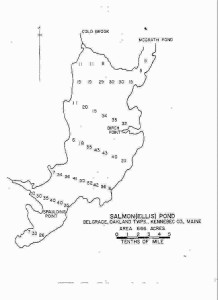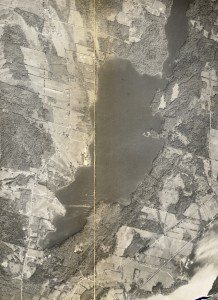Update on Plant life, July 1, 2017
From: Blanchette, Denise L
Sent: Friday, June 30, 2017 11:45 AM
To: Toni Pied)
Subject: Salmon Pond Survey
Good afternoon Toni,
Just wanted to report on our Salmon Pond survey this past Monday June 26th. We did a diver tow of Kozy Cove and found no Eurasian milfoil. I did notice that there was a lot more marigold this season and the M. tenelum was more dense than I have ever seen it anywhere!
Any questions let me know. Enjoy the holiday!
Denise
Denise Blanchette, Biologist, Maine Department of Environmental Protection
WATER QUALITY SUMMARY
Information regarding Salmon Lake can be obtained by following these links. vlmp@mainevlmp.org and www.7lakesalliance.org

SALMON LAKE (A/K/A Ellis P), Belgrade
Midas: 5352, Basin: Primary
The Maine Department of Environmental Protection (ME-DEP) and the Volunteer Lake Monitoring Program (VLMP) have collaborated in the collection of lake data to evaluate current water quality, track algal blooms, and determine water quality trends. This dataset does not include bacteria, mercury, or nutrients other than phosphorus.
Water quality monitoring data for Salmon Lake has been collected since 1975. During this period, 24 years of basic chemical information was collected, in addition to Secchi Disk Transparencies (SDT). In summary, the water quality of Salmon Lake is considered to be slightly below average, based on measures of SDT, total phosphorus (TP), and Chlorophyll-a (Chla). The potential for nuisance algal blooms on Salmon Lake is moderate to high.
Water Quality Measures: Salmon Lake is a non-colored lake (average color 15 SPU) with an average SDT of 4.9m (16.1ft). The range of water column TP for Salmon Lake is 9-25 parts per billion (ppb) with an average of 14 ppb, while Chla ranges from 1.4-25.9 ppb with an average of 5.6 ppb. Recent dissolved oxygen (DO) profiles show high DO depletion in deep areas of the lake. The potential for TP to leave the bottom sediments and become available to algae in the water column (internal loading) is high. Oxygen levels below 5 parts per million may stress certain cold-water fish, and a persistent loss of oxygen may eliminate or reduce habitat for sensitive cold-water species.

Salmon Pond’s watershed was surveyed in 1998; a watershed management plan was developed as part of the Great Pond Watershed Management Plan published in 2001. Erosion controls have been implemented in this watershed since 1996 with the assistance of the Belgrade Lakes Conservation Corps, the Kennebec County Soil and Water Conservation District and the Belgrade Regional Conservation Alliance. Additional information may be obtained by contacting the Belgrade Regional Conservation Alliance at 207-495-6039. Members of the Salmon/McGrath Pond Lake Association has been actively involved in monitoring both Salmon and McGrath Ponds for transparency, dissolved oxygen and other parameters for the better portion of nearly 3 decades.
See ME-DEP Explanation of Lake Water Quality Monitoring Report for measured variable explanations. Additional lake information can be found on the Internet at www.Pearl.maine.edu and/or www.maine.gov/dep/blwq/lake.htm, or by contacting ME-DEP at 207-287-3901 or VLMP at 207-783-7733.
